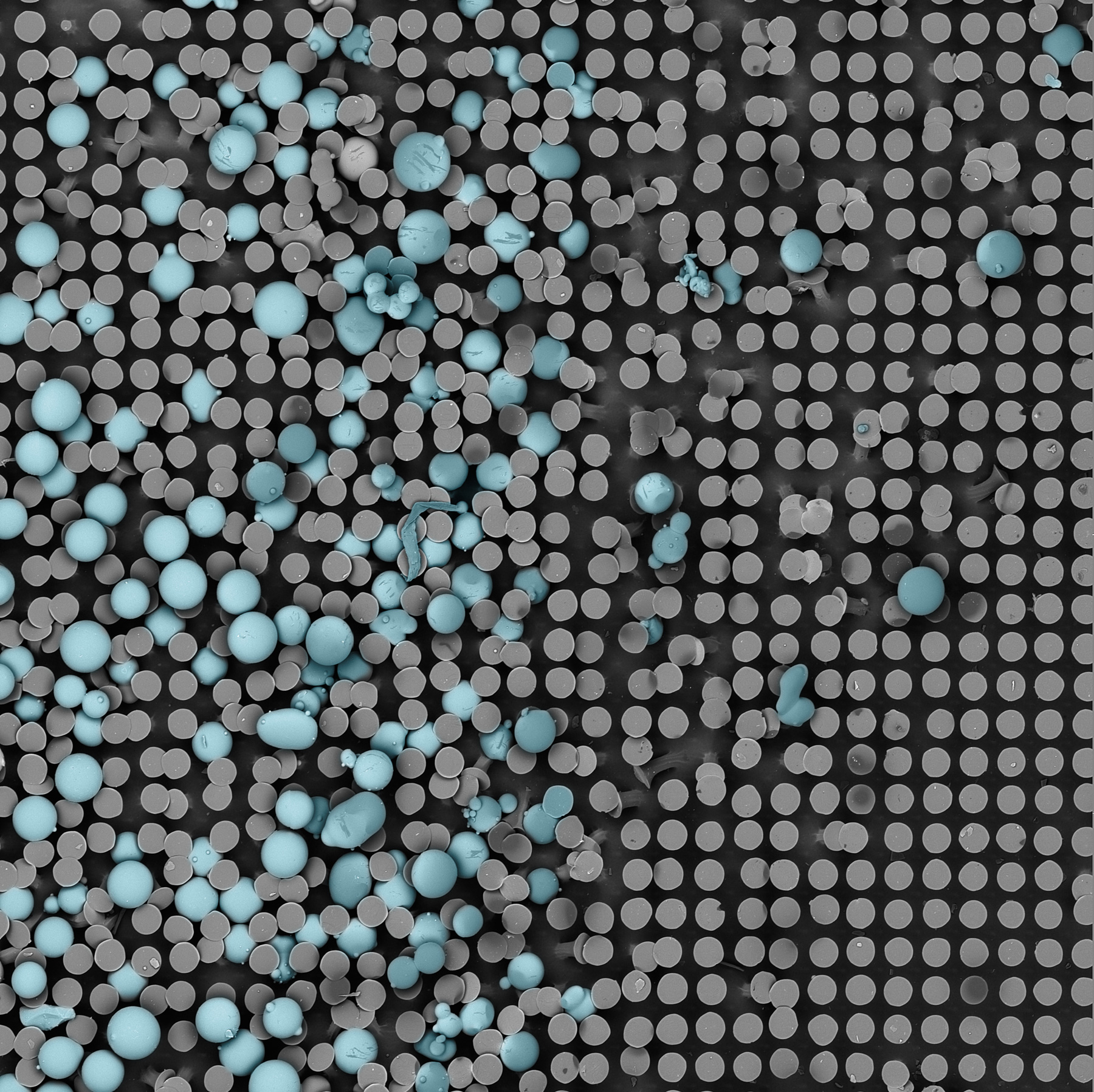Gecko-Inspired Adhesive
A reusable tape made of micro fibers has the remarkable ability to self-clean.

A magnified, "aerial" view of the gecko-inspired adhesive. The light blue dots represent debris, before (left) and after cleaning (right).
Even the stickiest tapes lose their strength over time as they get caked with dirt and grime—just think of your last whirl with a lint roller. But by taking a page from the gecko, researchers at Carnegie Mellon University, led by Metin Sitti, have developed a new adhesive that cleans itself, restoring its strength as efficiently as lizard toes can.
Sitti’s scientific interest in geckoes began after a trip he made more than 14 years ago to Thailand, where the creatures are abundant. At the time, he marveled at their maneuverability as they traversed ceilings and walls with ease. A few years later, as a mechanical engineer designing a small climbing robot, Sitti recalled the gecko’s clingy feet, and eventually began working on a synthetic version of the reptilian footpads.
In the field of bio-inspired engineering, the gecko is a popular model organism for research on adhesives: It can cling to virtually any material; its sticky feet leave no gummy residue like manmade glues often do; and unlike insect species that have similarly adhesive footpads, geckoes support bodies that weigh up to several pounds. “In that sense, they are definitely the most advanced climbing animals and climbing materials in nature,” says Sitti.
The secret to their acrobatics lies in millions of microscopic hairs that cover the gecko’s footpads. Molecules at the tips of those hairs interact with molecules on a given surface through phenomena called van der Waals forces. Individually, each force is relatively weak. “But if you have millions of these tiny hairs touching to the surface very well, then the total force is very significant,” says Sitti.
Sitti’s team developed fibers that work in much the same way as the gecko’s hairs, but they’re made from elastic polymers and feature flattened mushroom tips that serve as the critical points of contact. The fibers are organized into a grid pattern to form an adhesive, which looks a bit like Scotch tape.
Part of what makes an adhesive effective is how long it lasts. Importantly, the researchers found that their artificial fibers could also mimic the gecko’s ability to clear its footpads of dirt, which it does just by walking around. In the case of the synthetic, simply attaching and detaching the adhesive to a clean surface several times is enough to clean the fibers, though the product still needs to be fine-tuned for smaller debris.
Sitti’s team has tested how well self-cleaning works for fibers ranging from 20 to 95 microns across at the tips. They first sullied their adhesives with particles of glass as a stand-in for dirt, then cleaned the fibers by pressing them against a clean surface and peeling them away. Nine cycles of cleaning restored 80 percent of the adhesion when the glass particles were larger than the fibers, matching the gecko’s performance when dealing with proportionally sized contaminants. But if the particles were much smaller than the fibers, it took three more cycles for the adhesive to reinstate half as much stickiness. Based on these findings, the team plans to improve the adhesive by creating sub-micron-sized fibers that would better clean up smaller bits of dirt.
The possibilities for self-cleaning adhesives are virtually endless, says Sitti, from tricked-out goalie gloves and medical bandages to a quieter alternative to Velcro on clothes. Sitti has already started a company called nanoGriptech to commercialize his discoveries, and because the physics of van der Waals forces are the same in space, he says that NASA has shown interest.
Within a year, Sitti aims to have the first gecko-inspired product hit shelves—and peel right off.
Jessica McDonald is a health reporter for WHYY, Philadelphia’s public radio station. She is also a former Science Friday web intern.